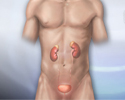Urinary incontinence - injectable implant
Intrinsic sphincter deficiency repair; ISD repair; Injectable bulking agents for stress urinary incontinence
Injectable implants are injections of material into the urethra to help control urine leakage (urinary incontinence) caused by a weak urinary sphincter. The sphincter is a muscle that allows your body to hold urine in the bladder. If your sphincter muscle stops working well, you will have urine leakage.
Description
The material that is injected is permanent. Coaptite and Macroplastique are examples of two brands.
The doctor injects material through a needle into the wall of your urethra. This is the tube that carries urine from your bladder out of your body. The material bulks up the urethral tissue, causing it to tighten. This stops urine from leaking out of your bladder.
You may receive one of the following types of anesthesia (pain relief) for this procedure:
- Local anesthesia (only the area being worked on will be numb)
- Spinal anesthesia (you will be numb from the waist down)
- General anesthesia (you will be asleep and not able to feel pain)
After you are numb or asleep from anesthesia, the doctor puts a medical device called a cystoscope into your urethra. The cystoscope allows your doctor to see the area.
Then the doctor passes a needle through the cystoscope into your urethra. Material is injected into the wall of the urethra or bladder neck through this needle. The doctor can also inject material into the tissue next to the sphincter.
The implant procedure is usually done in the hospital. Or, it is done in your doctor's office. The procedure takes about 20 to 30 minutes.
Why the Procedure Is Performed
Implants can help both men and women.
Men who have urine leakage after prostate surgery may choose to have implants.
Women who have urine leakage and want a simple procedure to control the problem may choose to have an implant procedure. These women may not want to have surgery that requires general anesthesia or a long recovery after surgery.
Risks
Risks for this procedure are:
- Damage to the urethra or bladder
- Urine leakage that gets worse
- Pain where the injection was done
- Allergic reaction to the material
- Implant material that moves (migrates) to another area of the body
- Trouble urinating after the procedure
- Urinary tract infection
- Blood in the urine
Before the Procedure
Tell your health care provider what medicines you are taking. This includes medicines, supplements, or herbs you bought without a prescription.
You may be asked to stop taking aspirin, ibuprofen (Advil, Motrin), naproxen (Aleve, Naprosyn), vitamin E, warfarin (Coumadin), and any other medicines that make it hard for your blood to clot (blood thinners).
On the day of your procedure:
- You may be asked not to drink or eat anything for 6 to 12 hours before the procedure. This will depend on what type of anesthesia you will have.
- Take the medicines your provider told you to take with a small sip of water.
- You will be told when to arrive at the hospital or clinic. Be sure to arrive on time.
After the Procedure
Most people can go home soon after the procedure. It may take up to a month before the injection fully works.
It may become harder to empty your bladder. You may need to use a catheter for a few days. This and any other urinary problems usually go away.
Outlook (Prognosis)
You may need 2 or 3 more injections to get good results. If the material moves away from the spot where it was injected, you may need more treatments in the future.
Implants can help most men who have had transurethral resection of the prostate (TURP). Implants help about one half of men who have had their prostate gland removed to treat prostate cancer.
References
Boone TB, Stewart JN, Martinez LM. Additional therapies for storage and emptying failure. In: Partin AW, Dmochowski RR, Kavoussi LR, Peters CA, eds. Campbell-Walsh-Wein Urology. 12th ed. Philadelphia, PA: Elsevier; 2021:chap 127.
Kobashi KC, Albo ME, Dmochowski RR, et al. Surgical treatment of female stress urinary Incontinence: AUA/SUFU Guideline. J Urol. 2017;198(4):875-883. PMID: 28625508 pubmed.ncbi.nlm.nih.gov/28625508/.
Lentz GM, Miller JL. Lower urinary tract function and disorders: physiology of micturition, voiding dysfunction, urinary incontinence, urinary tract infections, and painful bladder syndrome. In: Gershenson DM, Lentz GM, Valea FA, Lobo RA, eds. Comprehensive Gynecology. 8th ed. Philadelphia, PA: Elsevier; 2022:chap 21.
Review Date: 1/1/2023
Reviewed By: Kelly L. Stratton, MD, FACS, Associate Professor, Department of Urology, University of Oklahoma Health Sciences Center, Oklahoma City, OK. Also reviewed by David C. Dugdale, MD, Medical Director, Brenda Conaway, Editorial Director, and the A.D.A.M. Editorial team.


